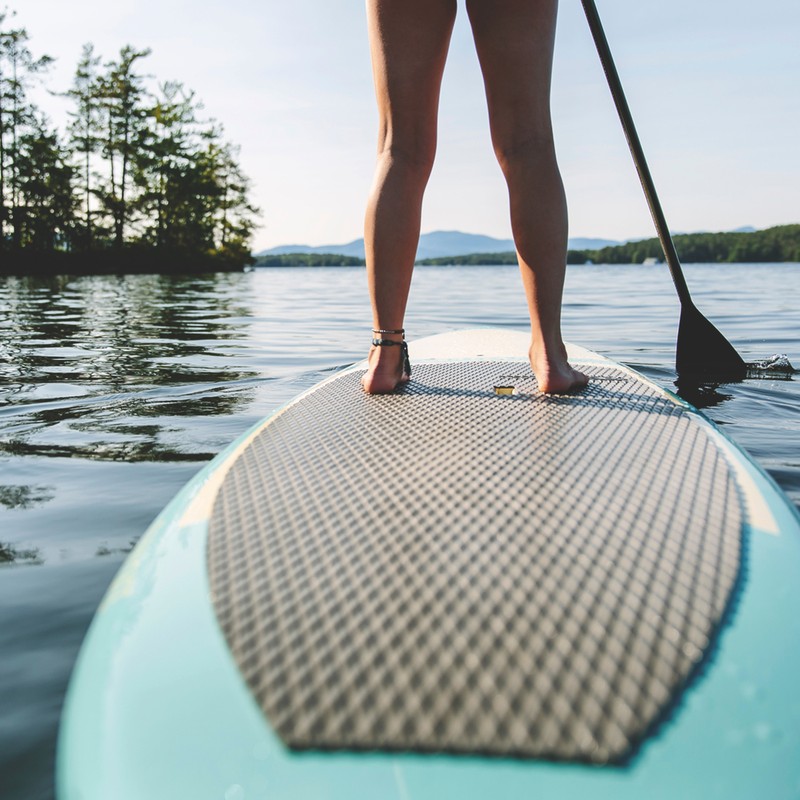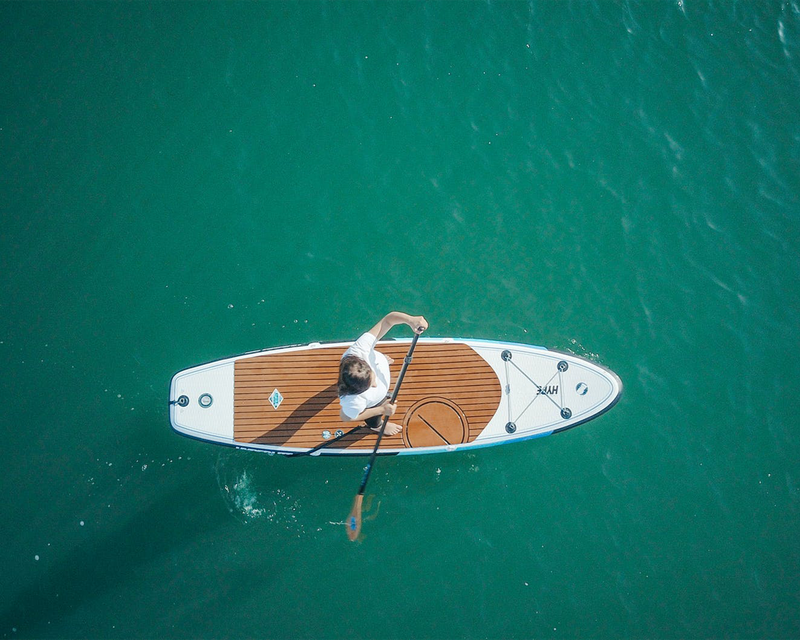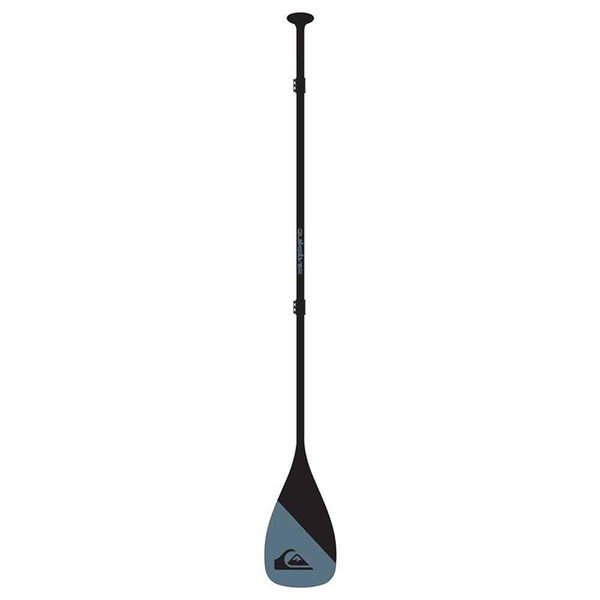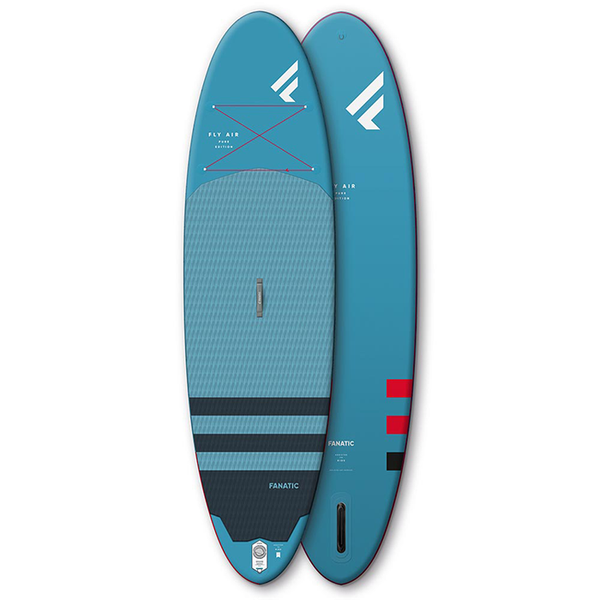
How To Get Into Paddleboarding
First, what is paddleboarding?
“SUP (stand up paddleboarding) is a sport where you use a single bladed paddle to manoeuvrer yourself on a large type of surfboard. Its roots go back to ‘outrigger paddling’ and surfing which was first seen in Hawaii back in the 1930s. SUP arrived in the UK in around 2006 and has since grown a huge following, particularly over the last few years.” – Simon Bassett, co-founder and chairman of the British Stand Up Paddleboarding Association
“A paddleboard looks like a large surfboard or windsurf board that’s either an inflatable or a hard model. Similar to canoeing, you drive yourself forward using the paddle. Although standing up is a popular way to do it, you can also kneel or sit on the board as you move around, depending on what you find most comfortable. If you’re planning on standing, then a paddle with a blade at one end and a T grip at the other would suit best, but if you prefer sitting, look for a paddle with a blade at each end or a seat pack.” – Chris Evans, paddleboarding instructor at National Outdoor Centre Plas y Brenin
What equipment do you need to get started?
“You need a board, a paddle and a leash (which attaches to your ankle and to the board to stop you losing it when you fall off). If you’re on the water for a few hours, I’d recommend buying a good wetsuit, too. A buoyancy aid is also a good safety option on rivers or tidal stretches if that’s where you’re aiming to go.” – Chris
“The size of the board you need depends on your weight. If you weight 55 to 80kgs, aim to find a board that’s around 10.4ft long. If you’re over 80kgs, look for a 10.8ft board. I would also recommend an adjustable small-bladed paddle which makes fast strokes easier to achieve.” – Simon
What’s the real difference between standing up and sitting down?
“SUP has become very popular in recent years because it’s more natural than sitting. It’s also more comfortable in my view and puts less stress on your back. You also get a better vision of your surroundings and it’s great for improving your fitness. When you stand up, it helps build your core strength and can torch calories. SUP is also a great way to destress, particularly SUP yoga, where the board becomes your yoga mat.” – Simon
Is it suitable for both adults and children?
“Very much so. Inflatable boards have made it easier for everyone. It’s also particularly popular with women because of its accessibility. You can paddleboard at a range of locations across the UK and ultimately, it’s really fun – you don’t have to be a surfer or water sports pro to get involved, it’s easy for beginners to get into it, too. SUP as a sport itself is like cycling where the stand-up paddleboard is the water equivalent of a water bicycle, making it a great workout for adults and children alike.” – Simon

Do you need to be a strong swimmer?
“No, but you should be confident in the water. I recommend beginner’s SUP lessons if you’re trying it for the first time. There are some good techniques to learn on how to paddle, turn, fall safely and self-rescue, which will be helpful during your time on the water. There are also basic safety skills that you should understand before venturing out – either inland or on the coast, which a teacher can help you master.” – Chris
What’s the best way to maximise a workout on the board?
“If you want to progress in any sport and get the most out of a workout, taking a lesson is always a good idea. If you want to maximise your workout, timing yourself on the water is a great way to challenge yourself, whether that’s racing, touring, or just going out for fun with friends. Paddleboarding is a fairly low-intensity workout, but standing up will help strengthen your core. Bend your legs slightly to get your glutes working even harder, and keep the board moving at all times, even if you just paddling along gently. An hour on the water can burn up to 450 calories for the average woman, depending on fitness levels.” – Simon
Why has it suddenly increased in popularity?
“Paddleboarding has become the fastest growing paddle sport thanks to how accessible it is. In fact, it’s fair to say that it’s exploded in the UK over the last few years. Specialist water sports shops are now stocking an excellent range of boards and paddles, and now that British holidaymakers are championing the staycation for another year, now’s a great time to give it a go.” – Chris
Feeling inspired? Here are Simon’s top tips for beginners:
1. Start with a lesson. You can find your local school at BSUPA.org.uk. Most lessons start with basic health and safety rules, followed by time on the water to get to grips with the board and paddle. When you progress, you can take more advanced lessons to improve your technique and maximise the board for a killer workout.
2. Master the health and safety protocols in your chosen location either inland or in the sea. Remember, we’re not fish so water is not our natural environment – be respectful to mother nature.
3. Develop a short paddle stroke and learn how to stand properly on the board. You should have a slight bend in the knees, a straight back and your feet should face forwards at all times. Keep your eyes forward, not on the paddle.
4. Invest in a good paddleboard. There’s no point buying the cheapest option as it won’t stand the test of time. Shop around, read reviews and check the safety requirements – a good boards should cost upwards of £300.
5. Paddle as much as you can with friends and venture to different bodies of water. The sea varies wildly from lakes and rivers, so try a range of locations.
6. Don’t venture too far from the shore – stay within 30 to 40 meters from the shoreline to be safe.
7. If paddleboarding on rivers, be sure to check the waterflow – you need little or no current to get going so don’t be fooled by fast flowing rivers.
8. Think about wind speed and direction – try and paddle in line with the wind which will help propel you forwards.
9. Always check the forecast before you head out. Don’t just rely on the weather forecast, check specialist wind sites, too.
10. Keep sessions short to start with so you can build your fitness and get a better understanding of the conditions. Paddleboarding is a full body workout, so pace yourself at first.


Here, Simon recommends the best places to paddleboard around the UK:
West Wittering, West Sussex
West Wittering is a great beach for beginners. The waves aren't too big and it’s a popular place with surfers and kite surfers. Hire equipment and take lessons at 2XS who offer a number of BSUPA courses for those interested in learning or improving their stand-up paddleboarding.
Daymer Bay, Cornwall
On the east side of the River Camel Estuary in north Cornwall, Daymer Bay is a great spot. Surrounded by dunes and sandhills, the water conditions vary but are mostly flat during the summer months.
Poole Harbour, Dorset
Take lessons with Easy Riders at Poole Harbour. There are several types of lesson to choose from, suitable for both adults and kids. As Britain’s largest harbour, it’s a stunning location for all types of water sports and it has a dedicated board area, too.
Newquay, Cornwall
When in Newquay, head to Surf Sanctuary who have a dedicated SUP school. The team are pros on the water and know the best spots in the area.
Farmoor Reservoir, Oxford
This stretch of the Thames is only accessible by permit, so book lessons with Oxford SUP Club. With over 15 million litres of fresh water on two huge lakes, just 5 miles from Oxford city centre, it’s a great spot for groups and families.
Bray Lake, Windsor
Hire a board from Bray Watersports or bring your own to paddle on Bray Lake in Windsor. Choose from hourly sessions or weekly courses to really improve your skills.
Blackwater Estuary, Essex
One of the best spots near London, Frangipanni SUP operates on the Blackwater Estuary. From beginner to instructor, there are a range of lessons to choose from. Frangipanni also venture out to the Trifarm swimming lake in Chelmsford and Home Water Lake at Chigborough Farm.
Scilly Isles
There are several great paddleboarding spots across the Scilly Isles. The Sailing Centre will take you to scenic beaches and hidden bays with quiet waters.
For more information visit BSUPA.org.uk and PYB.co.uk
Shop our paddleboard edit...






DISCLAIMER: We endeavour to always credit the correct original source of every image we use. If you think a credit may be incorrect, please contact us at info@sheerluxe.com.

